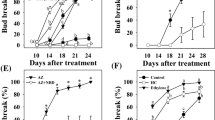Abstract
Hydrogen cyanamide (HC) is widely used to induce the breakage of endodormancy (ED) in grape and other deciduous fruit crop, though its mechanism of action is poorly understood. Applications of HC to grapevine buds produce oxidative stress and transient respiratory disturbances which are related to the breakage of ED. Moreover, since the expression and activity of catalase (Cat) is inhibited by HC, enhancements in the levels of H2O2 have also been associated to the breakage of ED in grapevine buds. Here, we reported that increases in H2O2 level in HC-treated grapevine buds are due to the inhibition of Cat activity and enhancement of the respiratory activity of buds. In addition, exogenous applications of H2O2 partially reproduced the inducing effect of HC in the breakage of ED, thus providing further support for the hypothesis that H2O2 mediates the effects of HC. On the other hand, Mit isolated from both control and HC-treated buds respired equally well when NADH was used as a respiratory substrate, but when succinate was used as an electron donor Mit respiration was non-detected, suggesting that the stimulatory effect of HC on bud respiration is related to metabolic alterations leading to increase of the concentration of NADH rather than to changes in Mit functionality.





Similar content being viewed by others
References
Chang S, Puryear J, Cairney J (1993) A simple and efficient method for isolating RNA from pine trees. Plant Mol Biol Rep 11:113–116
Dorey S, Bailleul F, Saindrenan P, Fritig B, Kaufman S (1998) Tobacco class I and II catalase are differentially expressed during elicitor-induced hypersensitive cell death and localized acquired resistance. Mol Plant Microbe Interact 11:1102–1109
Foyer CH, Halliwell B (1976) The presence of glutathione and glutathione reductase in chloroplast: A proposed role in ascorbic acid metabolism. Planta 133:21–25
Foyer CH, Noctor G (2005) Oxidant and antioxidant signalling in plants: a re-evaluation of the concept of oxidative stress in a physiological context. Plant Cell Environ 28:1056–1071
Foyer CH, López-Delgado H, Dat J, Scott IM (1997) Hydrogen peroxide and glutathione associated mechanisms of acclimatory stress tolerance and signalling. Physiol Plant 100:241–254
Hardie DG (1994) Ways of coping with stress. Nature 370:599–600
Moller IM (2001) Plant mitochondria and oxidative stress: electron transport, NADPH turnover, and metabolism of reactive oxygen species. Ann Rev Plant Physiol Plant Mol Biol 52:561–591
Nir G, Shulman Y, Fanberstein L, Lavee S (1986) Changes in the activity of catalase in relation to the dormancy of grape buds. Plant Physiol 81:1140–1142
Neil SJ, Desikan R, Clarke A, Hurst RD, Hancock JT (2002) Hydrogen peroxide and nitric oxide as signalling molecules in plants. J Exp Bot 53:1237–1247
Or E, Nir G, Vilozny I (1999) Timing of hydrogen cyanamide application to grapevine buds. Vitis 38:1–6
Or E, Vilozny I, Eyal Y, Ogrodovitch A (2000) The transduction of the signal for grapebud dormancy breaking induced by hydrogen cyanamide may involve the SNF-like protein-kinase GDBRPK. Plant Mol Biol 43:483–494
Or E, Vilozny I, Fennell A, Eyal Y, Ogrodovitch A (2002) Dormancy in grape buds :isolation and characterization of catalase cDNA and analysis of its expression following chemical induction of bud dormancy release. Plant Sci 162:121–130
Perata P, Alpi A (1993) Plant response to anaerobiosis. Plant Sci 93:1–7
Pérez FJ, Burgos B (2004) Alterations in the pattern of peroxidase isoenzymes and transient increases in its activity and in H2O2 levels take place during the dormancy cycle of grapevines buds: the effect of hydrogen cyanamide. Plant Growth Regul 43:213–220
Pérez FJ, Lira W (2005) Possible role of catalase in post-dormancy bud-break in grapevines. J Plant Physiol 162:301–308
Pérez FJ, Rubio S (2006) An improved chemiluminescence method for hydrogen peroxide determination in plant tissues Plant Growth Regul 48:89–95
Rasmusson AG, Soole KH, Elthon TE (2004) Alternative NAD(P)H dehydrogenases of plant mitochondria. Ann Rev Plant Biol 55:23–39
Salvemini F, Franzé A, Iervolino A, Filosa S, Salzano S, Ursini MV (1999) Enhanced Glutathione levels and oxidoresistance mediated by increased glucose-6-phosphate dehydrogenase expression. J Biol Chem 274:2750–2757
Sanz P (2003) SNF1 protein kinase: a key player in the response to cellular stress in yeast. Biochem Soc Trans 31:176–181
Shulman Y, Nir G, Lavee S (1983) The effect of cyanamide on the release from dormancy of grapevine buds. Sci Hortic 19:97–104
Acknowledgements
Financial support of FONDECYT project 1050285 is gratefully acknowledged.
Author information
Authors and Affiliations
Corresponding author
Rights and permissions
About this article
Cite this article
Pérez, F.J., Vergara, R. & Rubio, S. H2O2 is involved in the dormancy-breaking effect of hydrogen cyanamide in grapevine buds. Plant Growth Regul 55, 149–155 (2008). https://doi.org/10.1007/s10725-008-9269-4
Received:
Accepted:
Published:
Issue Date:
DOI: https://doi.org/10.1007/s10725-008-9269-4




